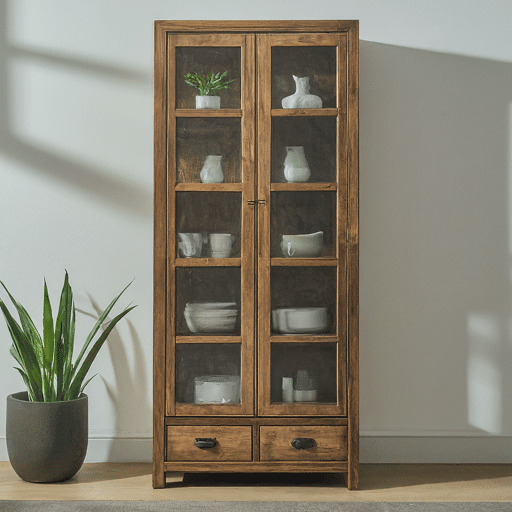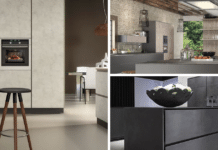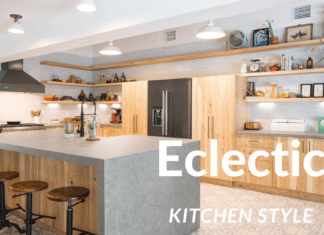When it comes to kitchen design, a growing trend is catching everyone’s attention: kitchens without upper cabinets.
This minimalist and sleek look has been gaining popularity in recent years as homeowners embrace the idea of open and airy kitchen spaces.
Opting for a kitchen design without upper cabinets or modern-style frameless cabinets can impart a minimal and contemporary aesthetic to your space, allowing you to utilize open Shelving to adorn your kitchen walls.
In this blog, we will explore the concept of kitchens without upper cabinets, including the trend’s appeal, design strategies for implementation, practical storage solutions with wall cabinets, and the stylish alternative of open Shelving.
Whether you’re planning a kitchen remodel or enhancing your kitchen’s aesthetics, this blog offers valuable kitchen trends insights and inspiration for maximizing storage space, even in small homes with narrow galley kitchens.
Kitchen With No Top Cabinets Ideas
By removing the wall cabinetry, these kitchens provide expanses of bare walls, which can be used for decorative purposes and showcase unique design elements.
Here, find a curated selection of kitchens devoid of upper cabinets across various layouts, floor plans, settings, and color schemes to inspire your remodeling endeavors.
Glass-front Cabinets for Enhanced Versatility
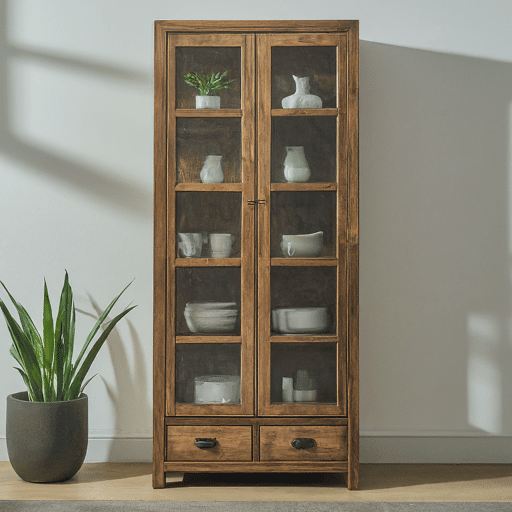
Glass-front cabinets combine closed storage with open shelving to create a spacious feel while hiding clutter.
Open shelving is favored for showcasing dishware and efficient organization, evolving into minimalist single shelves above lower cabinets.
This trend focuses on aesthetics, decluttering, and optimizing kitchen essentials in modern kitchens. It frees up wall space by omitting upper cabinets, enhancing openness, and making the room feel larger.
Floating shelves offer practical storage solutions for a more spacious and organized kitchen.
Dark Oak Cabinets with Lower Cabinet Emphasis
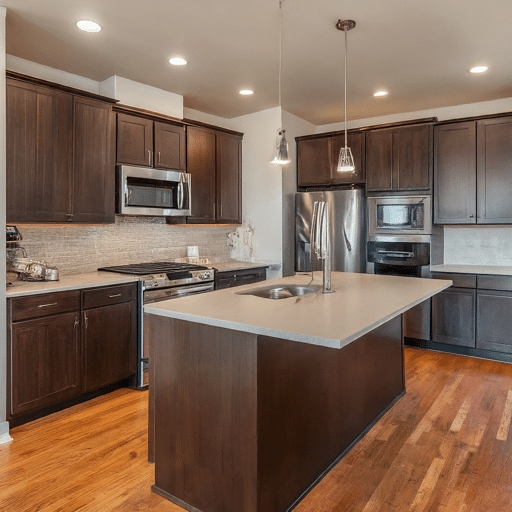
Embrace a lighter ambiance by incorporating dark oak cabinets exclusively in the lower section of your kitchen.
This design choice fosters a spacious feel, complemented by a harmonious blend of natural wood tones, creating a visually appealing living space.
Open Shelving to Notch up Personal Style
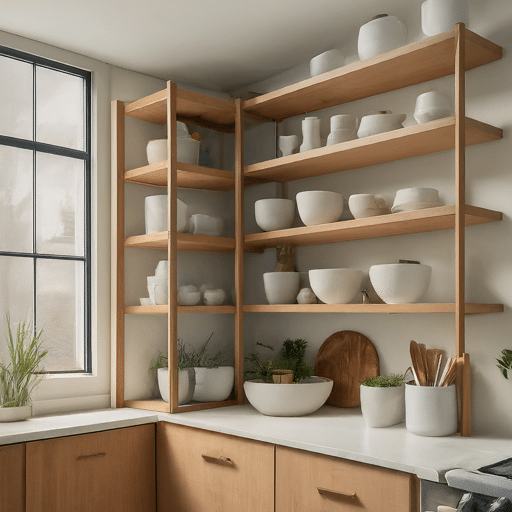
Open Shelving in kitchens is a stylish alternative to upper cabinets, providing both decorative display space and practical storage for everyday items.
Showcase ceramics, cookbooks, and kitchen essentials to visually impact design and create a focal point.
The arrangement of Open Shelving, also known as kitchen shelving, combines function and display for versatile use in kitchens without upper cabinets.
The open shelving opens space and allows natural light from living room windows to create a brighter atmosphere.
Corner Layout with Storage Optimization
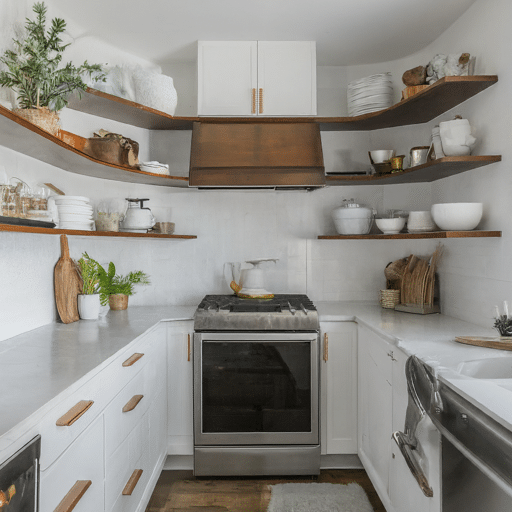
Focusing on lower cabinets and a centrally positioned island maximizes storage efficiency in corner kitchen layouts.
This configuration minimizes reliance on upper cabinets, except for essential elements such as a sleek range hood and elegant wall lamps.
Wall Shelf Alternatives
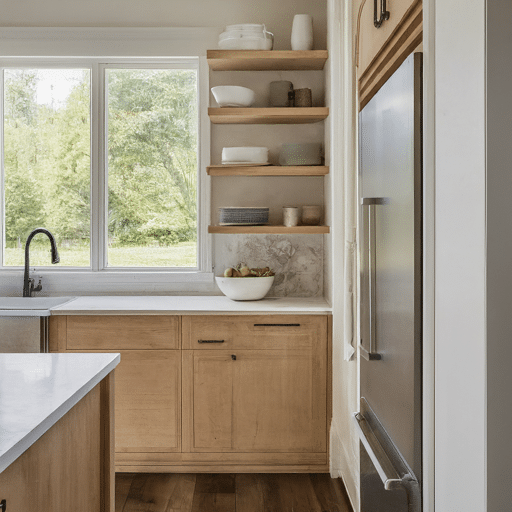
To capitalize on natural light in kitchens with limited wall space between windows, upper cabinets should be replaced with functional wall shelves.
These shelves store kitchen essentials while accommodating decorative elements like serving dishes and artwork.
Innovative Solutions for Unconventional Spaces
Navigate challenging floor plans with creativity by adapting kitchen designs to suit unconventional spaces.
Open Shelving and niche storage solutions offer practical alternatives when upper cabinets may overwhelm the area.
Integration of Kitchen Islands for Enhanced Storage
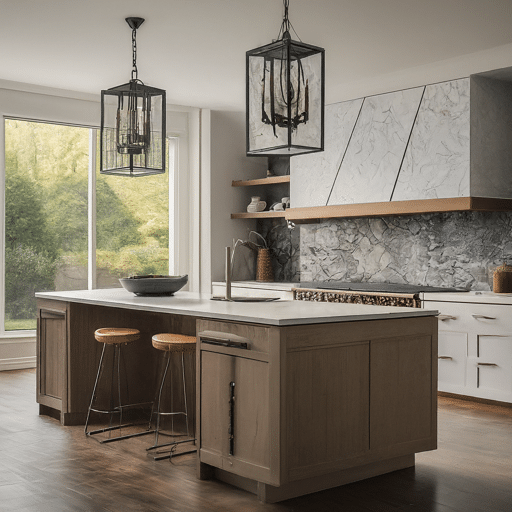
Incorporate expansive kitchen islands equipped with cabinets and drawers to augment storage capacity.
These islands are complemented by striking marble countertops and contrasting task lighting as multifunctional focal points.
Galley Kitchen Layouts with Accent Lighting
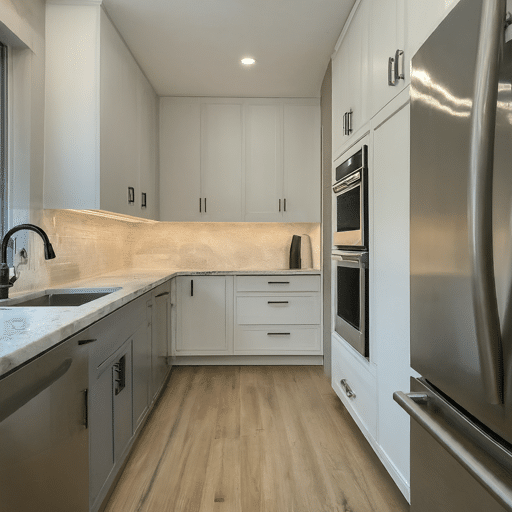
Embrace the efficiency of galley kitchen layouts by prioritizing lower cabinets on both sides. With uncluttered upper areas, accent pendant lights above critical features such as the sink can take center stage.
Utilization of Floating Shelves and Peg Rails
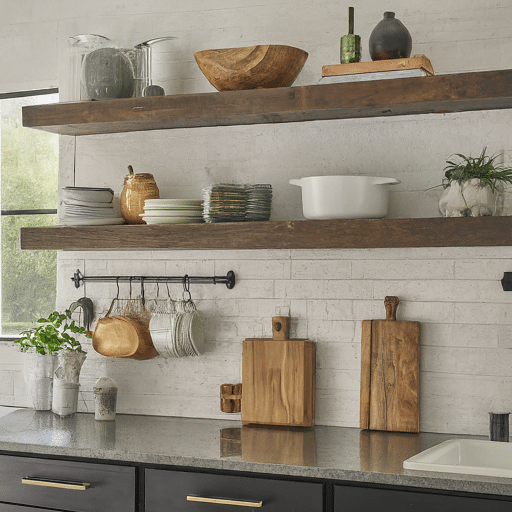
Opt for floating shelves and peg rails to replace traditional upper cabinets. These design elements foster a sense of openness and versatility, offer storage solutions, and contribute to the kitchen’s aesthetic appeal.
Highlighting Architectural Features
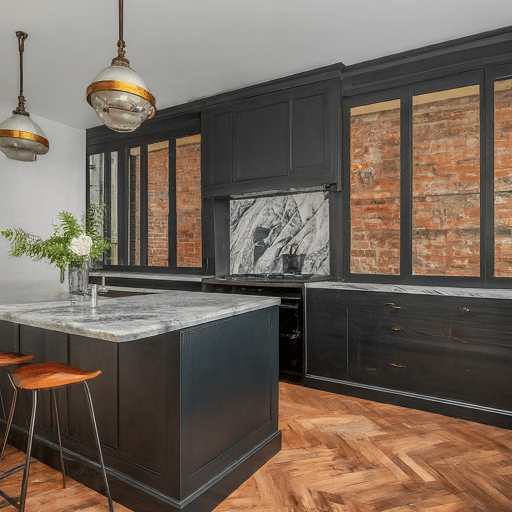
Eliminating upper cabinets emphasizes architectural elements in historic kitchens, allowing intricate details such as dark cabinetry and herringbone flooring to shine.
The strategic placement of black marble accents further enhances the visual impact.
Small Niche Kitchens with Efficient Storage Solutions
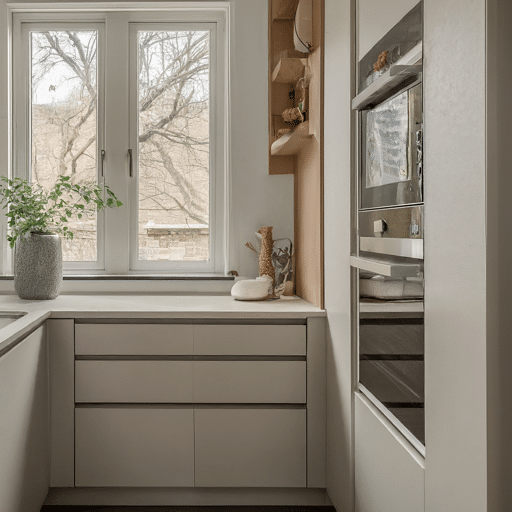
Adapt small niche spaces with a blend of tall cupboards and lower cabinetry, ensuring practicality without compromising aesthetics.
Neutral color palettes and natural stone countertops create an airy atmosphere within confined quarters.
Whether you prefer a minimalist look or enjoy displaying unique artwork and ceramics, kitchens without upper cabinets provide a blank canvas for creativity and self-expression.
However, before opting for a kitchen without cabinets, it is recommended that you compare modern and traditional cabinets in style.
By incorporating creative storage options and highlighting architectural elements, you can create a contemporary, roomy kitchen that reflects your style choices and space limitations.
Open shelving is popular for those looking to add a personal touch to their kitchen. It allows for an eye-level display of art and decor elements.
Also Read: The 4-Step Kitchen Plan To The Perfect Design
How Removing Upper Cabinets Transforms Your Kitchen’s Aesthetics
Removing upper cabinets from your kitchen can transform its aesthetics, giving it a modern and streamlined look.
This change allows other design elements, like statement backsplashes and unique countertops, to stand out. It also opens up opportunities for adding visual interest with features like decorative shelves or artwork.
Without upper cabinets, you can choose materials and colors that complement your design, creating a visually stunning space in your own kitchen.
Additionally, removing upper kitchen cabinets can create a more open feeling in the kitchen, allowing for better lighting and the illusion of more counter space to work with.
By completely eliminating upper kitchen cabinets, you can keep the kitchen free from clutter and chaos.
In addition, it makes your small kitchen look bigger and balances streamlined minimalism and luxurious comfort in your kitchen design.
Also Read: 9 Cabinet Ideas for a Low-Maintenance Kitchen
No Upper Cabinets: Practical Benefits, Pros and Cons
Opting for a kitchen design without upper cabinets can offer an open, airy atmosphere and foster a sense of spaciousness.
However, this choice also challenges storage and organization, requiring thoughtful planning to maximize functionality while maintaining aesthetic appeal.
So here, learn about the practical benefits, pros, and cons of no-upper cabinets and how to make the most of your cabinet space.
Practical Benefits:
- Convenience: Accessible shelves make it easier to retrieve dishes, utensils, and ingredients, especially for busy households or frequent entertainers.
- Motivation for cleanliness: Open Shelving encourages maintaining a clean and organized kitchen environment.
- Visibility: Items stored on open shelves are easily visible, reducing the chances of forgetting about them or buying duplicates.
Pros:
- Enhanced aesthetic appeal: Skipping upper cupboards can give the kitchen a distinctive and visually appealing look.
- Flexible use of wall space: Larger kitchens can use wall space to install windows and tiles or create storage/display niches.
- Customizable shelving options: Shelving can be tailored to suit various design preferences using materials like wood, wire, melamine, or glass.
- The illusion of spaciousness: The absence of upper cupboards creates a perception of a larger kitchen, offering more design flexibility.
- Showcase decorative elements: Open Shelving allows homeowners to display elegant dishware and kitchen items, enhancing the overall ambiance
Cons:
- Dust accumulation: Open Shelving can collect dust, requiring regular cleaning and maintenance.
- Visual clutter: Poorly arranged shelves can detract from the kitchen’s aesthetic appeal.
- Maintenance challenges: Individuals must assess their ability to keep the shelves organized and visually appealing, which may be challenging for some.
- Limited privacy: Contents of open shelves are exposed, which may only be ideal for some, especially those with a preference for concealed storage.
Design Strategies for Kitchens Without Upper Cabinets
Designing a kitchen without upper cabinets requires thoughtful planning and consideration. Several design strategies can be employed to ensure functionality and style, especially in small spaces.
These include maximizing natural light and windows for a spacious feel, choosing suitable materials and colors for a cohesive look, and incorporating task lighting to enhance functionality without upper cabinets.
By implementing these strategies, you can create a stylish and practical kitchen featuring custom cabinets that work well in less space. Eye-level artwork and lighting add a unique touch to the design.
If you’re considering a new kitchen, explore the option of lower cabinets made-to-order to fit your specific needs and budget.
Leveraging Natural Light and Windows for a Spacious Feel
Design kitchens without upper cabinets to maximize natural light and create a spacious feel.
Position the layout to optimize light, placing key areas near windows. Choose light-enhancing window treatments.
By incorporating windows and a strategically placed dining area, you enhance the connection with the outdoors, bringing openness and a fresh atmosphere to your kitchen for a functional and pleasing place.
Choosing Suitable Materials and Colors for a Cohesive Look
Designing a kitchen without upper cabinets requires selecting materials and colors that match your style.
Coordinate kitchen handles and knobs, countertops, backsplashes, and flooring with lower cabinets for a cohesive look.
Maximize storage with kitchen islands, high cupboards, side storage, and lower drawers for an organized space.
How Custom Cabinetry and Paint Create a Calm Kitchen Atmosphere
Creating a serene kitchen environment is all about thoughtful design choices. Custom cabinetry and carefully selected paint play pivotal roles in crafting this tranquil space.
1. Tailored to Fit Your Space
Custom cabinetry offers a personalized approach, ensuring every inch of your kitchen is utilized effectively.
By optimizing layout and storage, you eliminate clutter, which naturally promotes a sense of calm. Cabinets tailored to your needs help maintain an organized space, reducing stress caused by disarray.
2. Harmonizing Colors
Paint choices significantly impact a room’s ambiance. Soft, neutral hues like pale blues, gentle greens, or warm greys can evoke a sense of calm and relaxation.
These colors create a backdrop that soothes the senses, transforming the kitchen into a peaceful retreat.
3. Cohesive Design
With custom cabinetry, you can choose materials and finishes that match seamlessly with your paint and overall kitchen theme.
This harmony of elements contributes to a serene atmosphere, as visual consistency fosters a feeling of balance and order.
4. Enhancing Natural Light
Light-colored cabinetry and paint can enhance the natural light in your kitchen, making the space feel more open and airy. A brighter kitchen looks bigger and exudes a refreshing and calming vibe.
In essence, the combination of custom cabinetry and thoughtful paint choices is key to cultivating a kitchen atmosphere that feels calm and inviting.
You can create a functional and tranquil kitchen by prioritizing design elements that promote organization and harmony.
Conclusion
By embracing the trend of kitchens without upper cabinets, you open up the space and create a sleek, modern look.
Leveraging natural light and choosing suitable materials can make your kitchen feel spacious and cohesive. Innovative storage solutions like kitchen islands and open shelving offer functionality and style.
Maximize wall space with corner layouts and galley designs. Unique ideas, such as a focal wall shelf and utilizing the back of a kitchen island for storage, add personality to your space.
Whether this trend is staying or not, functional kitchens without upper cabinets are here to stay, offering a unique blend of practicality and aesthetics.
FAQs
Here are frequently asked questions about kitchen upper cabinets.
Can a Kitchen be Functional Without Upper Cabinets?
Yes, a kitchen can be functional without upper cabinets. This allows for a more streamlined and open design while providing ample storage for all your needs.
By utilizing lower cabinets and other storage solutions, such as open Shelving or a kitchen island with additional cabinets and drawers, you can create enough storage space for your kitchen items.
How Do I Maximize Storage in a Kitchen Without Upper Cabinets?
To maximize storage in a kitchen without upper cabinets, you can utilize lower cabinetry to its fullest potential. This can be done by incorporating pull-out drawers, adjustable shelves, and organizers to maximize the available space.
Additionally, consider adding a kitchen island with extra cabinets and drawers and incorporating open Shelving for both storage and display purposes.
Can You Have a Kitchen Without Upper Cabinets?
Yes, it is possible to have a kitchen without upper cabinets. Utilizing alternative storage solutions such as open Shelving or incorporating lower cabinetry to its fullest potential can create a functional and stylish kitchen without the need for upper cabinets.
This design choice allows for a more open and airy space, making the kitchen feel larger and less cluttered.

